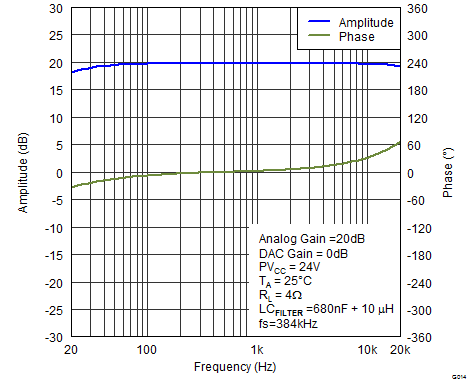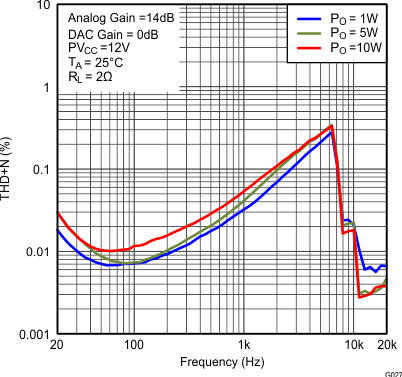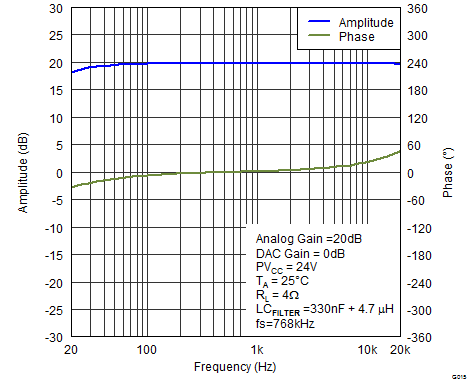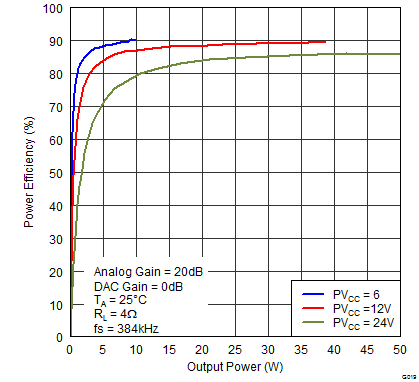SLAS965D September 2013 – October 2018 TAS5766M , TAS5768M
PRODUCTION DATA.
- 1 Features
- 2 Applications
- 3 Description
- 4 Revision History
- 5 Pin Configuration and Functions
- 6 Specifications
-
7 Detailed Description
- 7.1 Overview
- 7.2 Functional Block Diagram
- 7.3 Feature Description
- 7.4
Device Functional Modes
- 7.4.1 Device Protection System
- 7.4.2 Reset and System Clock Functions
- 7.4.3 System Clock PLL Mode
- 7.4.4 Clock Generation and PLL
- 7.4.5 PLL Calculation
- 7.4.6 Audio Data Interface
- 7.4.7
TAS576xM Audio Processing Options
- 7.4.7.1 Overview
- 7.4.7.2 miniDSP Instruction Register
- 7.4.7.3 Digital Output
- 7.4.7.4 Software
- 7.4.7.5 Process Flow
- 7.4.7.6 Zero Data Detect
- 7.4.7.7 Power Save Modes
- 7.4.7.8 XSMT Pin (Soft Mute/Soft Un-Mute)
- 7.4.7.9 External Power Sense Undervoltage Protection Mode
- 7.4.7.10 Recommended Power Down Sequence
- 7.5 Programming
- 7.6 Register Maps
- 8 Applications and Implementation
- 9 Power Supply Recommendations
- 10Layout
-
11Register Map Information
- 11.1
Detailed Register Map Descriptions
- 11.1.1 Register Map Summary
- 11.1.2
Page 0 Registers
- 11.1.2.1 Page 0 / Register 1 (Hex 0x01)
- 11.1.2.2 Page 0 / Register 2 (Hex 0x02)
- 11.1.2.3 Page 0 / Register 3 (Hex 0x03)
- 11.1.2.4 Page 0 / Register 4 (Hex 0x04)
- 11.1.2.5 Page 0 / Register 7 (Hex 0x07)
- 11.1.2.6 Page 0 / Register 8 (Hex 0x08)
- 11.1.2.7 Page 0 / Register 9 (Hex 0x09)
- 11.1.2.8 Page 0 / Register 10 (Hex 0x0A)
- 11.1.2.9 Page 0 / Register 12 (Hex 0x0C)
- 11.1.2.10 Page 0 / Register 13 (Hex 0x0D)
- 11.1.2.11 Page 0 / Register 20 (Hex 0x14)
- 11.1.2.12 Page 0 / Register 21 (Hex 0x15)
- 11.1.2.13 Page 0 / Register 22 (Hex 0x16)
- 11.1.2.14 Page 0 / Register 23 (Hex 0x17)
- 11.1.2.15 Page 0 / Register 24 (Hex 0x18)
- 11.1.2.16 Page 0 / Register 27 (Hex 0x1B)
- 11.1.2.17 Page 0 / Register 28 (Hex 0x1C)
- 11.1.2.18 Page 0 / Register 29 (Hex 0x1D)
- 11.1.2.19 Page 0 / Register 30 (Hex 0x1E)
- 11.1.2.20 Page 0 / Register 32 (Hex 0x20)
- 11.1.2.21 Page 0 / Register 33 (Hex 0x21)
- 11.1.2.22 Page 0 / Register 34 (Hex 0x22)
- 11.1.2.23 Page 0 / Register 35 (Hex 0x23)
- 11.1.2.24 Page 0 / Register 36 (Hex 0x24)
- 11.1.2.25 Page 0 / Register 37 (Hex 0x25)
- 11.1.2.26 Page 0 / Register 40 (Hex 0x28)
- 11.1.2.27 Page 0 / Register 41 (Hex 0x29)
- 11.1.2.28 Page 0 / Register 42 (Hex 0x2A)
- 11.1.2.29 Page 0 / Register 43 (Hex 0x2B)
- 11.1.2.30 Page 0 / Register 44 (Hex 0x2C)
- 11.1.2.31 Page 0 / Register 59 (Hex 0x3B)
- 11.1.2.32 Page 0 / Register 65 (Hex 0x41)
- 11.1.2.33 Page 0 / Register 66 (Hex 0x42)
- 11.1.2.34 Page 0 / Register 82 (Hex 0x52)
- 11.1.2.35 Page 0 / Register 83 (Hex 0x53)
- 11.1.2.36 Page 0 / Register 84 (Hex 0x54)
- 11.1.2.37 Page 0 / Register 85 (Hex 0x55)
- 11.1.2.38 Page 0 / Register 86 (Hex 0x56)
- 11.1.2.39 Page 0 / Register 87 (Hex 0x57)
- 11.1.2.40 Page 0 / Register 90 (Hex 0x5A)
- 11.1.2.41 Page 0 / Register 91 (Hex 0x5B)
- 11.1.2.42 Page 0 / Register 92 (Hex 0x5C)
- 11.1.2.43 Page 0 / Register 93 (Hex 0x5D)
- 11.1.2.44 Page 0 / Register 94 (Hex 0x5E)
- 11.1.2.45 Page 0 / Register 95 (Hex 0x5F)
- 11.1.2.46 Page 0 / Register 108 (Hex 0x6C)
- 11.1.2.47 Page 0 / Register 118 (Hex 0x76)
- 11.1.2.48 Page 0 / Register 119 (Hex 0x77)
- 11.1.2.49 Page 0 / Register 120 (Hex 0x78)
- 11.1.2.50 Page 0 / Register 121 (Hex 0x79)
- 11.1.3 Page 1 Registers
- 11.1.4 Page 44 Registers
- 11.1
Detailed Register Map Descriptions
- 12Device and Documentation Support
- 13Mechanical, Packaging, and Orderable Information
Package Options
Mechanical Data (Package|Pins)
Thermal pad, mechanical data (Package|Pins)
- DCA|48
Orderable Information
6.9 Typical Characteristics
All measurements taken at 1kHz, unless otherwise noted. Measurements were made using the TAS5766MDCA EVM.







| Thermally limited for dashed lines | ||





vs Frequency

vs Power








| Thermally limited for dashed lines | ||




| Thermally limited for dashed lines | ||

vs Frequency

vs Power